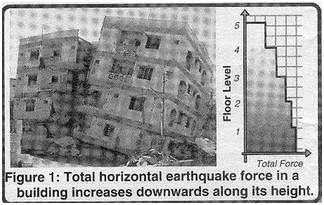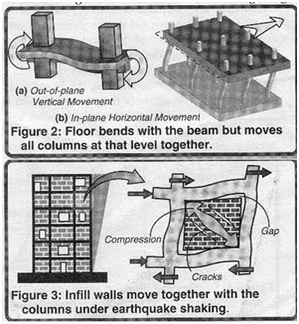





Published on Nov 30, 2023
An earthquake is the vibration, sometimes violent to the earth's surface that follows a release of energy in the earth's crust. This energy can be generated by a sudden dislocation of segments of the crust, by a volcanic eruption or even by a manmade explosion. The dislocation of the crust causes most destructive earthquakes.
The crust may first bend and then the stresses exceed the strength of rocks, they break. In the process of breaking, vibrations called seismic waves are generated. These waves travel outward from the source of the earthquake along the surface and through the earth at varying speeds depending on the material through which they move. These waves can cause disasters on the earth's surface.
No structure on the planet can be constructed 100% earthquake proof; only its resistance to earthquake can be increased. Treatment is required to be given depending on the zone in which the particular site is located. Earthquake occurred in the recent past have raised various issues and have forced us to think about the disaster management. It has become essential to think right from planning stage to completion stage of a structure to avoid failure or to minimize the loss of property. Not only this, once the earthquake has occurred and disaster has taken place; how to use the debris to construct economical houses using this waste material without affecting their structural stability
Since the magnitude of a future earthquake and shaking intensity expected at a particular site cannot be estimated with a reasonable accuracy, the seismic forces are difficult to quantify for the purposes of design. Further, the actual forces that can be generated in the structure during an earthquake are very large and designing the structure to respond elastically against these forces make it too expensive.
Therefore, in the earthquake resistant design post yield inelastic behavior is usually relied upon to dissipate the input seismic energy. Thus the design forces of earthquakes may be only a fraction of maximum (probable) forces generated if the structure is to remain elastic during the earthquake. For instance, the design seismic for buildings may at times be as low as one tenths of the maximum elastic seismic force. Thus, the earthquake resistant construction and design does not aim to achieve a structure that will not get damaged in a strong earthquake having low probability of occurrence; it aims to have a structure that will perform appropriately and without collapse in the event of such a shaking.
Ductility is the capacity of the structure to undergo deformation beyond yield without loosing much of its load carrying capacity. Higher is the ductility of the structure; more is the reduction possible in its design seismic force over what one gets for linear elastic response. Ensuring ductility in a structure is a major concern in a seismic construction.
In recent times, reinforced concrete buildings have become common in India. A typical RC building is made of horizontal members (beams and slabs) and vertical members (columns and walls) and supported by foundations that rest on the ground. The system consisting of RC columns and connecting beams is called a RC frame.

The RC frame participates in resisting earthquake forces. Earthquake shaking generates inertia forces in the building, which are proportional to the building mass. Since most of the building mass is present at the floor levels, earthquake induced inertia forces primarily develop at the floor levels. These forces travel downward through slabs to beams, beams to columns and walls and then to foundations from where they are dispersed to the ground. As the inertia forces accumulate downward from the top of the building (as shown in fig3.1) , the columns and walls at the lower storey experience higher earthquake induced forces and are therefore designed to be stronger than the storey above.
Floor slabs are horizontal like elements, which facilitates functional use of buildings. Usually, beams and slabs at one storey level are cast together. In residential multistoried buildings, the thickness of slab is only about 110mm-150mm. when beams bend in vertical direction during earthquakes, these thin slabs bend along with them. When beams move in horizontal direction, the slab usually forces the beams to move together with it.

In most of the buildings, the geometric distortion of the slab is negligible in the horizontal plane; the behavior is known as rigid diaphragm action. After columns and floors in a RC building are cast and the concrete hardens, vertical spaces between columns and floors are usually filled in with masonry walls to demarcate a floor area into functional spaces. Normally, these masonry walls are called infill walls, are not connected to surrounding RC beams and columns. When the columns receive horizontal forces at floor levels, they try to move in the horizontal direction, but masonry wall tend to resist this movement.
Due to their heavy weight and thickness, these walls develop cracks once their ability to carry horizontal load is exceeded. Thus, infill walls act like sacrificial fuses in the buildings, they develop crack under severe ground shaking but help share the load the load of beams and columns until cracking.
For a building to remain safe during earthquake shaking columns (which receive forces from beams) should be stronger than beams and foundations (which receive forces from columns) should be stronger than columns. Further the connections between beams and columns, columns and foundations should not fail so that beams can safely transfer forces to columns and columns to foundations.
When this strategy is adopted in the design, damage is likely to occur first in beams. When beams are detailed properly to have large ductility, the building as a whole can deform by large amounts despite progressive damage caused due to consequent yielding of beams.
If columns are made weaker, localized damage can lead to the collapse of building, although columns at storey above remain almost undamaged.
Severity of ground shaking at a given location during earthquake can be minor, moderate and strong. Relatively speaking, minor shaking occurs frequently; moderate shaking occasionally and strong shaking rarely. For instance, on average annually about 800 earthquakes of magnitude 5.0-5.9 occurs in the world, while the number is only 18 for the magnitude ranges 7.0-7.9. Since it costs money to provide additional earthquake safety in buildings, a conflict arises ‘should we do away with the design of buildings for earthquake effects? Or should we design the building to be earthquake proof wherein there is no damage during strong but rare earthquake shaking. Clearly the formal approach can lead to a major disaster and second approach is too expensive. Hence the design philosophy should lie somewhere in between two extremes.
The engineers do not attempt to make earthquake proof buildings that will not get damaged even during the rare but strong earthquake; such buildings will be too robust and also too expensive. Instead, engineering intention is to make buildings earthquake resistant, such building resists the effects of ground shaking, although they may get damaged severely but would not collapse during the strong earthquake. Thus, safety of peoples and contents is assured in earthquake resistant buildings and thereby, a disaster is avoided. This is a major objective of seismic design codes through the world.
The earthquake design philosophy may be summarized as follows:
• Under minor, but frequent shaking, the main members of the building that carry vertical and horizontal forces should not be damaged; however the building parts that do not carry load may sustain repairable damage.
• Under moderate but occasional shaking, the main member may sustain repairable damage, but the other parts of the building may be damaged such that they may even have to be replaced after the earthquake.
• Under strong but rare shaking, may sustain severe (even irreparable) damage, but the building should not collapse.
Thus after minor shaking, the building will be operational within a short time and repair cost will be small and after moderate shaking, the building will be operational once the repair and strengthening of the damaged main members is completed. But, after a strong earthquake, the building may become disfunctional for further use, but will stand so that people can be evacuated and property recovered.
The consequences of damage have to be kept in view in the design philosophy. For example, important buildings like hospitals and fire stations play a critical role in post earthquake activities and must remain functional immediately after earthquake. These structures must sustain very little damage and should be designed for a higher level of earthquake protection. Collapse of dams during earthquake can cause flooding in the downstream reaches, which itself can be a secondary disaster. Therefore, dams and nuclear power plants should be designed for still higher level of earthquake motion.
| Are you interested in this topic.Then mail to us immediately to get the full report.
email :- contactv2@gmail.com |